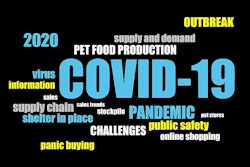
There is no shortage of information and surveys available about how the COVID-19 has affected every aspect of life, including consumer behavior. Case in point: Two recent surveys addressed shopping behavior when it comes to human food and pet products (including pet food), respectively. While different in scope, the surveys provide some interesting comparisons.
For example, in “Identifying Solutions for Retail Frustrations: Consumer Pain Points During COVID-19,” a survey of food retail consumers, those who expressed the most concern about the food supply chain reside in the New England, East South Central or West South Central region of the U.S. In the other report, “COVID-19 Pulse Study: Pet Ownership During the Pandemic,” pet owners from the U.S. Midwest or South were more likely to say they were shopping as usual for pet products.
With both reports, the timing of the relevant surveys may be a factor in how people responded. The one on pet ownership was conducted by the American Pet Products Association (APPA) in June; at that point, cases of COVID-19 were relatively lower in the South and, except for large cities, the Midwest. The same with rural communities, also named by APPA as a source of lower change in pet product shopping behavior.
It's unclear when the food retail survey, organized by Menu Matters and CIO, was fielded, but the findings may indicate similar timing. For instance, the report said the fact that almost 50% of respondents were extremely or very concerned about the food supply chain was “likely driven by broad shortages during the height of the crisis and media coverage of concerns relating to potential meat shortages.” Those shortages, or concern they might be coming, happened even earlier, starting in April.
More shortages with human food, lower brand loyalty
Whenever the food retail survey was conducted, respondents reported they were still experiencing shortages and out-of-stock situations with the food products they were seeking; in fact, nearly 100% said so. As a result, 58% switched to a new brand for specific categories and planned to stick with that new brand – not a positive result for brand loyalty, at least not for the formerly used products.
Out-of-stock situations were far less of a problem for pet owners in June, at least the ones responding to the APPA survey: 81% were able to find the specific brand of pet food they wanted at the first outlet they tried, with another 8% successful at a different retailer. Additionally, two-thirds said they were able to find the pet treats they sought on their first try.
Perhaps as a result, pet food consumers seem more brand loyal, with 55% of respondents saying they consider themselves very brand loyal when it comes to shopping for pet food and other items, while 71% said that, because their pets’ diets are very important to them, they do not plan to make changes no matter what happens with the economy or their own financial situations. That sentiment likely has more to do with the pets’ health and well-being, but strikes a positive note for brand loyalty, too.
Addressing those financial situations directly, the APPA survey asked respondents about their intentions regarding pet food purchases. Only 16% said that, in their current circumstances or the overall economy, they planned to spend less money on pet food, and the same percentage said they plan to switch to a different pet food brand to save money.
Move toward DTC, home delivery, curbside pickup
As the pandemic has driven more consumers online and away from in-store visits, more companies, including human food producers, are launching direct-to-consumer (DTC) initiatives. They may be onto something, as 37% of the respondents to the food retail survey said they would prefer to purchase directly from a manufacturer, at least to some degree. For men and millennials, the percentages were even higher, at 42% and 44%, respectively.
As reasons for this preference, respondents cited factors such as fewer product shortages and trips to the grocery store (both at 41%), lower prices (40%), convenience (37%) and a greater product variety (35%).
The APPA survey did not delve into DTC and, in fact, revealed that at least for these pet owners, purchasing pet food at a brick-and-mortar store – discount/mass market outlet, pet superstore or supermarket – is still their preferred option, with just 15% buying from an online-only outlet. Further, 69% shopped for their most recent pet food purchases in person in a store. Yet 13% did order online and have the pet food delivered, while 11% ordered online and picked it up curbside; 37% said they had used these options before COVID-19, 19% said they did so for the first time during the pandemic and planned to continue doing so in the future.
View our continuing coverage of the coronavirus/COVID-19 pandemic.















